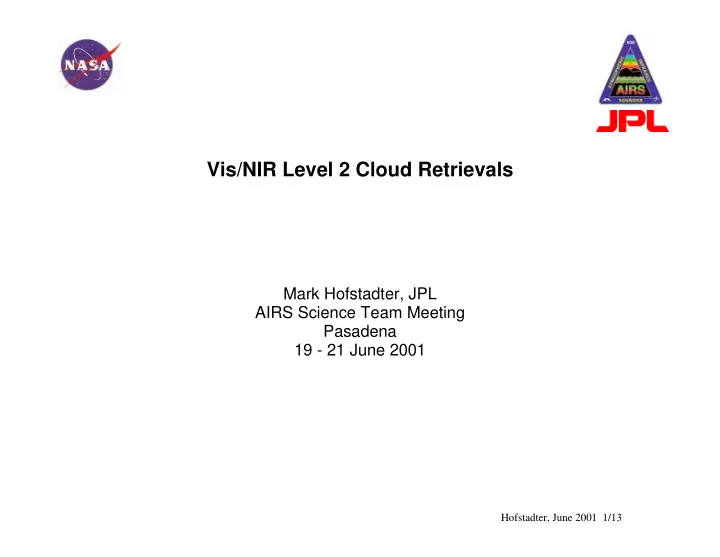

Vis/NIR Level 2 Cloud Retrievals Mark Hofstadter, JPL AIRS Science Team Meeting Pasadena 19 - 21 June 2001 Hofstadter, June 2001 1/13
Vis/NIR L2 Cloud Retrievals The UC Santa Barbara team has reported results from their cloud detection algorithm when it is applied to real MODIS data. I will discuss its performance against our simulated data sets which, while less realistic, have the advantage of our knowing the “true” geophysical conditions. Due to some confusion with our CM system, the May 29 exercise was run with an invalid Vis/NIR L2 cloud retrieval. When retrievals are re- run, global statistics on performance will be available. For this meeting, ran three granules to get a feel for the performance against our simulated data. Hofstadter, June 2001 2/13
Channel 1 Radiances, Granule 208 Channel 3 Radiances, Granule 208 Hofstadter, June 2001 3/13
Vis/NIR L2 Cloud Retrievals 1.0 0.9 0.8 Vis Retrieved Cloud Fraction 0.7 0.6 0.5 0.4 0.3 0.2 0.1 0.0 0.0 0.1 0.2 0.3 0.4 0.5 0.6 0.7 0.8 0.9 1.0 IR True Cloud Fraction GRANULE 208 (Pacific Ocean, Baja, and parts of Mexico) 12150 Points Total IR True Clear = 3090 Total Vis Retrieved Clear = 2449 Total Vis False Clear = 492 (614 raw) Total Vis Missed Clear = 0 (1255 raw) Vis/NIR L2 Cloud Retrievals Hofstadter, June 2001 4/13
1.0 Only Low-Cloud Present 0.9 (13 Cases) 0.8 Vis Retrieved Cloud Fraction 0.7 0.6 0.5 0.4 0.3 0.2 0.1 0.1 0.2 0.3 0.4 0.5 0.6 0.7 0.8 IR True Low-Cloud Fraction GRANULE 208 (Pacific Ocean, Baja, and parts of Mexico) 13 Points Only IR Footprints with one cloud layer, and cloud-top pressure > 500 mbar Vis/NIR L2 Cloud Retrievals Hofstadter, June 2001 5/13
1.0 Only High, Ice Clouds 0.9 (54 Points) 0.8 Vis Retrieved Cloud Fraction 0.7 0.6 0.5 0.4 0.3 0.2 0.1 0.1 0.2 0.3 0.4 0.5 0.6 0.7 0.8 0.9 IR True Cloud Fraction GRANULE 208 (Pacific Ocean, Baja, and parts of Mexico) 54 Points Only IR Footprints with one cloud layer, cloud-top pressure < 500 mbar, and cloud-top temperature < 253 K Hofstadter, June 2001 6/13
Channel 1 Radiances, Granule 207 Channel 3 Radiances, Granule 207 Hofstadter, June 2001 7/13
Vis/NIR L2 Cloud Retrievals 1.0 All Cases (12,150) 0.9 Low-Cloud (247), Offset by 0.1 High, Ice-Cloud (587), Offset by 0.2 0.8 Vis Retrieved Cloud Fraction 0.7 0.6 0.5 0.4 0.3 0.2 0.1 0.0 0.0 0.1 0.2 0.3 0.4 0.5 0.6 0.7 0.8 0.9 1.0 IR True Cloud Fraction GRANULE 207 (Equatorial Pacific Ocean) Total IR True Clear = 1953 Total Vis Retrieved Clear = 1909 Total Vis False Clear = 598 Total Vis Missed Clear = 0 Hofstadter, June 2001 8/13
Channel 1 Radiances, Granule 110 Channel 3 Radiances, Granule 110 Hofstadter, June 2001 9/13
Vis/NIR L2 Cloud Retrievals 1.1 1.0 0.9 Vis Retrieved Cloud Fraction 0.8 0.7 0.6 0.5 0.4 All Cases (12,150) 0.3 Low-Cloud (260), Offset by 0.1 High, Ice-Cloud (1,035), Offset by 0.2 0.2 0.1 0.0 0.0 0.1 0.2 0.3 0.4 0.5 0.6 0.7 0.8 0.9 1.0 IR True Cloud Fraction GRANULE 110 (Eastern Mediterranean, Eastern Europe) Total IR True Clear = 462 Total Vis Retrieved Clear = 2311 Total Vis False Clear = 1929 Total Vis Missed Clear = 0 Hofstadter, June 2001 10/13
Vis/NIR L2 Cloud Retrievals The variance of Vis/NIR L1B radiances may also be a good indicator of the presence of clouds. This approach has worked well with AVHRR data. Hofstadter, June 2001 11/13
90 180 80 Ch1 St. Dev (W/m**2/ster/micron) 160 Ch1 St. Dev (W/m**2/ster/micron) 70 140 60 120 50 100 40 80 30 60 20 40 10 20 0 0.0 0.1 0.2 0.3 0.4 0.5 0.6 0.7 0.8 0.9 1.0 0 0.0 0.1 0.2 0.3 0.4 0.5 0.6 0.7 0.8 0.9 1.0 IR True Cloud Fraction IR True Cloud Fraction Stan. Dev. of Ch. 1 Radiance vs. Cloud Fraction over Land (Granule 110) Stan. Dev. of Ch. 1 Radiance vs. Cloud Fraction over Ocean (Granule 207) Hofstadter, June 2001 12/13
Vis/NIR Cloud Retrievals Conclusions The L2 Vis/NIR cloud detection algorithm appears to be working fairly well. Many false detections result from the algorithm’s assumption that high thin cirrus clouds, when present, are likely to appear in many nearby pixels–an assumption not incorporated into the simulated data. Some clouds may be missed due to thresholds being optimized for conditions more realistic than are simulated (sunglint being one example). Software “switches” will be used in future exercises to optimize results when working with simulated data. In the future, we also intend to explore how effective L1B threshold and variability tests are in detecting clouds as compared to the more sophisticated L2 analysis. Hofstadter, June 2001 13/13
Recommend
More recommend